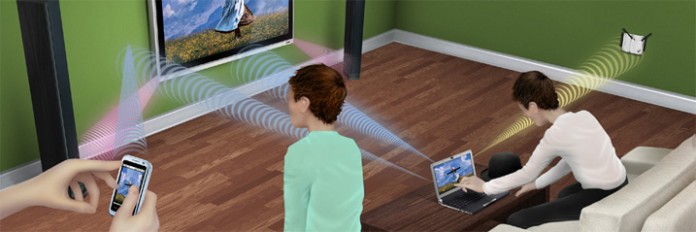The WiFi standard will get one of its biggest and most important updates ever next year when the first circuits with support for the 60 GigaHertz band launches. Marvell and Wilocity have now presented a joint development that promises tri-band circuits with speeds up to 7 Gigabit per second.
Marvell and Wilocity are not the first to develop circuits for the 60 Gigahertz band. Israeli Wilocity presented a joint project with Qualcomm Atheros for developing WiFi circuits with support for the 802.11ad specification earlier on. These circuits target notebooks and will be ready this year with a capacity of 5 Gigabit per second.
Marvell and Wilocity will focus on a broader market for their WiFi circuits that support all three popoular frequency bandwidths; 2.4 GHz, 5 GHz and the all new 60 GHz. The Tri-band circuits will launch in 2013, but is not expected to appear in products on a broad front until 2014. The big advantage of Marvell’s and Wilocity’s circuits is that they will appear in a variety of product areas.
The full size WiFi circuits for notebooks, docking stations, media centers and other wireless network equipment are expected to deliver an impressive bandwidths of 7 Gigabit per second, far above the 1.3 Gigabit per second that the fresh 802.11ac standard will offer in theory over the 5 GHz band. Energy consumption is not expected to go above 2.5 watt. We should mention that while the 60 GHz band is more sensitive to long distances it doesn’t need as many data channels over the 5 GHz band (between 80 to 160 channels) for maximal capacity.

“Sparrow” turns mobile phones into speed monsters
Wiocity and Marvell is working on one more 802.11ad circuit code-named Sparrow that will launch by the end of 2013. This circuit will offer data speeds up to 2.5 Gigabit per second and with an energy consumption of a mere 500 milliwatt it targets smartphones and tablets.
The cost for manufacturing products using the 60 GHz band will not be much higher than current 802.11n products that promises speeds between 0.3 to 0.45 Gigabit per second. Together with the extreme speeds this is the biggest thing that has happened to our wireless network in a very long time, says Wilocity VP Mark Grodzinsky.
“The .11ac standard took a lot of people’s attention this year—it’s seen as a .11n replacement,”[…]“Now people are looking at what else is interesting and finding the .11ac boost is nice and necessary but this [60 GHz technology] is the real game changer,” – Mark Grodzinsky to EEtimes.
The first products with Marvell’s and Wilocity’s 802.11ad tri-band circuits will appear near the end of next year, but is estimated to break through in 2014. Then the focus will be on wireless transfers of audio and video, and docking stations and wireless storage. Areas where the shortcoming of current technology will not be so obvious.















